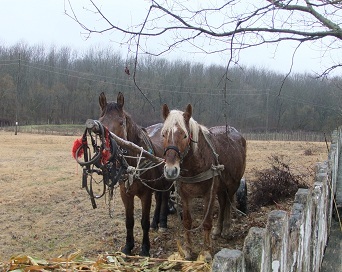A month into my time here, and it was time to see a different side of modern Orthodoxy. Generally, I wouldnt even put the words modern and Orthodoxy in the same sentence, let alone different. But then a fellow student invited me to see what theyre doing at his parish church.
The event was billed as a memorial the traditional sharing of food in memory of the dead, which occurs in all Orthodox churches on Sundays and on other days of the week. But in this case, the church had taken seriously Christs injunction about inviting the poor to the banquet. Rather than simply handing out food, the church hosts a Saturday lunch in their parish hall, attended by around fifty people, mostly living in a nearby social housing block or on the streets. Staffed by volunteers, the event is an opportunity for food and fellowship, as well as practical support with issues such as obtaining identity documents.

[I thought it would be rude to take photos of the guests, so I just took a photo of this little pussy cat pisica in Romanian who was also enjoying the hospitality of the parish hall]
Compared with what Ive seen in the UK, the approach was a little paternalistic, or perhaps I should say maternalistic the meal was accompanied by improving stories told by the priests mother. But the food was fantastic: for the second time since Ive been here, Ive sat back satisfied from my dish of filling soup, only to find theres a whole course yet to come!
It was also an impressive example of how a churchs social action programme can be integrated into the spiritual and liturgical life of the parish. Providing meals for the homeless is hardly a novel idea; there are plenty of similar initiatives in the Church of England. But this meal had been funded by a young couple, who were present, in memory of a late relative, and the meal started with sung prayers and the censing of the food and the guests. Fr Vasile is clear that this is not just charity but an honour and a spiritual devotion. Nobody can simply donate money: they must also prepare with prayer and fasting for their role as host. The church already has sponsors signed up for every week until Easter.

[A memorial food blessing though this one is in the church]
Fr Vasiles church is an authorised mission-parish of the Lords Army. Like its near-namesake the Salvation Army, the Lords Army started as a temperance movement and welfare organisation amongst alcoholics, gamblers and other addicts. Members are still very careful about alcohol, although I was privileged (and somewhat amused!) to be offered wine with my lunch. Founded in the 1920s by Fr Iosif Trifa of Sibiu, the Lords Army focuses on personal holiness, faith, and an individual relationship with Christ. When my friend talked about people giving their lives to Christ, I could have imagined that I was in an evangelical church!
Unsurprisingly, this movement proved controversial in the Orthodox church, and Trifa was excommunicated. After his death, however, the movement was rehabilitated; they run this parish with the full support of the hierarchy. The organisation is clear that it stands for spiritual renewal within the Orthodox church.

The next day, I got to see what that means in practice. The liturgy was certainly Orthodox, but the congregation was a little different. Compared with the city-centre churches Id mostly attended, the congregation was more gender-balanced and less affluent and they were sitting down! Or at least they could if they wanted to, since the church has benches. It also has bible verses and Lords Army banners on the walls. But what made me feel most at home was collecting my service sheet as I came in! As well as the readings and notices it contained two hymns the first time Ive seen the congregation sing anything which wasnt part of the liturgical text. I had the momentary impression that a bunch of Methodists had stumbled into an Orthodox church!

And the parallels with early Methodism continued. Just as Wesleys followers initially attended services at their parish churches as well as additional Methodist meetings, the Lords Army meets on a Sunday evening for something quite different from the Liturgy. Gathered in the parish hall, different people took it in turns to lead bible reflections and prayers from the front including lay people, both men and women. In between we sang hymns, accompanied by an electric keyboard. I may have been over-egging it when I called it modern – old-school hymns with no projector and definitely no waving arms but in the Orthodox church even playing an instrument of any kind at all during worship is seriously controversial.

The Lords Army is clearly doing something positive here. From the little Ive seen, it is managing to reach groups who are less well-represented elsewhere – men, younger people, the marginalised. It is providing teaching in a church where religious instruction was once virtually impossible (the Communists liked the priests to shut up and do the services, and keep their congregations dumb). And where it differs from Methodism is that it has managed to do all this and remain within the church. The meeting in the church hall might aesthetically appear protestant but the teaching was directly from the Fathers.
At the same time, the movement is undoubtedly controversial. It isnt just that electric keyboard. Even I felt uncomfortable hearing the founder, Iosif Trifa, being described as the prophet. Since the 1990s, Romania has become a recruiting ground for many Protestant denominations some of them, ironically, adopting Lords Army hymns – and the protestant-influenced ideas and practices which were simply alien to Romanians previously are now familiar and highly suspect. The Lords Army is not a liberal movement in some senses, as a movement for greater discipline and holiness, it is quite the opposite. But can a movement which preaches individual relationship with Christ and promotes lay ministry really leave Orthodox theology and practice unchanged?

[a banner commemorating the founders of the Lords Army]
And the influence isnt all one way. The next week, I accompanied the only other Anglican in Iaşi to a Pentecostal service with a difference. The Watchman Church is part of the Pentecostal Union of Romania, but its not a typical Pentecostal church; for a start, the leadership includes Baptist and Anglican members, and works closely with Catholic and Orthodox clergy.
Protestant denominations in Romania are sometimes accused of being un-Romanian; of importing, for instance, American worship songs. Here, they are trying to be true to the heritage of Romanian spiritual culture which of course means Orthodox culture. The church might be a bare hall with a lectern, but the ubiquitous table of bread, cakes and fruit was here too! The extempore prayer included some familiar phrases such as slava tie doamne (Glory to thee, O Lord) and the hymns included settings of the Trisagion, Sanctus / Benedictus and Gloria, although of course not in their liturgical places. They even say the creed without the Filioque: we are Eastern.
All this might give the impression that Romania is a bit of an ecumenical melting-pot. A keyboard in an Orthodox church or a Sanctus in a Pentecostal one is little more than window-dressing and maybe missing the point but they are signs of deeper convergences. The Watchman church is open about having a more sacramental theology of the Eucharist than once it did, and the Lords Army is learning from Protestant insights. Lords Army hymns are apparently popular in evangelical churches here! Unfortunately, the two groups still seem to be observing each other from a distance. Ecumenism is still a dirty word for many in the Orthodox, Pentecostal and Baptist churches here; even those groups which are open to insights from outside their boundaries might stop short of describing those people as fully Christians or fully members of the Church. For now, those few who desire unity can find themselves making a choice: make peace with others, or keep the peace at home.
















